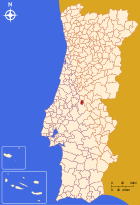Sardoal
| Sardoal | ||||||
|---|---|---|---|---|---|---|
|
||||||
| Basic data | ||||||
| Region : | Centro | |||||
| Sub-region : | Médio Tejo | |||||
| District : | Santarém | |||||
| Concelho : | Sardoal | |||||
| Coordinates : | 39 ° 32 ′ N , 8 ° 10 ′ W | |||||
| Residents: | 2404 (as of June 30, 2011) | |||||
| Surface: | 30.01 km² (as of January 1, 2010) | |||||
| Population density : | 80 inhabitants per km² | |||||
| Sardoal district | ||||||
|
||||||
| Residents: | 3939 (as of June 30, 2011) | |||||
| Surface: | 92.15 km² (as of January 1, 2010) | |||||
| Population density : | 43 inhabitants per km² | |||||
| Number of municipalities : | 4th | |||||
| administration | ||||||
| Administration address: | Câmara Municipal de Sardoal Praça da República 2230-222 Sardoal |
|||||
| President of the Câmara Municipal: | Fernando Constantino Moleirinho | |||||
| Website: | www.cm-sardoal.pt | |||||
Sardoal is a small town ( Vila ) and a district ( Concelho ) in Portugal with 2404 inhabitants (as of June 30, 2011).
history
A Roman road led through what is now the district area. Sardoal was first officially mentioned in 1313 when it received its city charter ( Foral ) from Queen Elizabeth of Portugal , the Rainha Santa Isabel ( Portuguese for: Holy Queen Isabel). In 1531 King João I elevated Sardoal to vila (small town with extended administrative rights), and in the following year it became an independent district of Abrantes .
Around the time of the Portuguese voyages of discovery at the beginning of the 16th century, the place experienced a heyday. The local facilities of the Santa Casa da Misericórdia charity were opened in 1509 , the seven oil paintings by the Master of Sardoal (Portuguese: Mestre de Sardoal) were created in 1510 , the Igreja da Misericórdia church was consecrated in 1551 , and some of the town's residents took part participated in various voyages of discovery through time.
Sardoal suffered looting and some destruction by French forces during the Napoleonic invasions in the early 19th century.
Culture and sights
The architectural monuments of Sardinia include various historical residential houses, stone fountains, public buildings and sacred buildings , including the Convento de Nossa Senhora da Caridade, which dates back to a hospital dating back to 1400 and was built in the 16th century, with its mannerist monastery church ( Igreja do Mosteiro de Nossa Senhora da Caridade ), which already shows baroque features in its furnishings such as azulejos and altarpieces .
In the church Igreja de São Tiago e de São Mateus (Portuguese for: Church of St. Jacobus and St. Matthew) there are seven panel paintings by the still unknown master of Sardoal from the beginning of the 16th century .
The historic town center as a whole is also a listed building.
administration
The circle
Sardoal is the administrative seat of a district of the same name. The neighboring areas are (starting clockwise in the north): Vila de Rei , Mação and Abrantes .
The following municipalities ( freguesias ) are in the Sardoal district:
| local community | Population (2011) |
Area km² |
Density of population / km² |
LAU code |
|---|---|---|---|---|
| Alcaravela | 904 | 36.77 | 25th | 141701 |
| Santiago de Montalegre | 229 | 17.00 | 13 | 141702 |
| Sardoal | 2,404 | 30.01 | 80 | 141703 |
| Valhascos | 402 | 8.37 | 48 | 141704 |
| Sardoal district | 3,939 | 92.15 | 43 | 1417 |
Population development
| Population in the Sardoal district (1801–2011) | |||||||||
|---|---|---|---|---|---|---|---|---|---|
| 1801 | 1849 | 1900 | 1930 | 1960 | 1981 | 1991 | 2001 | 2004 | 2011 |
| 4 213 | 4 480 | 5 804 | 6 863 | 6 854 | 5 022 | 4 430 | 4 104 | 3,992 | 3,948 |
Municipal holiday
- September 22
Web links
- Map of the Freguesia Sardoal at the Instituto Geográfico do Exército
- Official website
Individual evidence
- ↑ www.ine.pt - indicator resident population by place of residence and sex; Decennial in the database of the Instituto Nacional de Estatística
- ↑ a b Overview of code assignments from Freguesias on epp.eurostat.ec.europa.eu
- ↑ www.ine.pt - indicator resident population by place of residence and sex; Decennial in the database of the Instituto Nacional de Estatística
- ↑ www.verportugal.net , accessed on February 6, 2013
- ↑ www.monumentos.pt , accessed on February 6, 2013
- ↑ ditto







